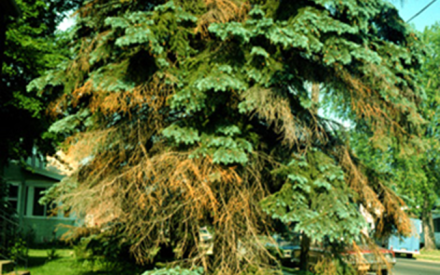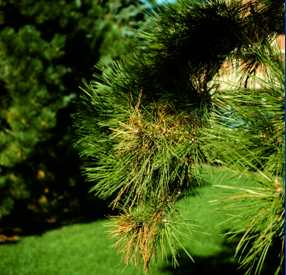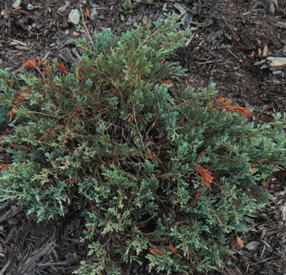
What is Dothistroma needle blight?
Dothistroma needle blight is a common needle disease that can affect over thirty species of pine trees. In Wisconsin, Austrian pines are most commonly and severely affected by this disease.
What does Dothistroma needle blight look like?
Dothistroma needle blight first appears as dark green, water-soaked spots on the needles. The spots become tan, yellow, or reddish-brown, and may encircle the needles to form bands. The tip of the needle beyond the band eventually dies, leaving the base of the needle alive and green. Young trees are more likely to suffer damage than older trees. Seedlings (< 1 yr. old) can be killed within a year after infection.
Where does Dothistroma needle blight come from?
Dothistroma needle blight is caused by the fungus Dothistroma pini, which survives in diseased needles. Watch for tiny, black reproductive structures of the fungus (called pycnidia) that can be found erupting from the surface of infected needles. Spores are produced in these structures throughout the growing season, and infection by spores can occur at any time, but particularly during periods of wet weather. Symptoms appear from five weeks to six months after infection.
How do I save a tree with Dothistroma needle blight?
Copper-containing fungicides (e.g., Bordeaux mix) can help prevent new infections, but will not cure diseased needles. Typically a single fungicide application in early June is sufficient to provide protection of new foliage. However, a second application three to four weeks later will provide more complete control. Be sure to read and follow all label instructions of the fungicide that you select to ensure that you use the product in the safest and most effective manner possible. Several years of treatments may be needed to completely rid a tree of all infected needles (through natural needle loss).
How do I avoid problems with Dothistroma needle blight in the future?
DO NOT plant Austrian pines as they are extremely susceptible to Dothistroma needle blight. Consider using other conifers instead. If you decide to plant susceptible trees, make sure the trees are disease-free at the time of planting. Also, be sure to provide adequate spacing between the trees to ensure good airflow and promote rapid needle drying. If you have established trees that are suffering from Dothistroma needle blight, remove fallen needles from around the base of these trees as these can serve as a source of fungal spores.
For more information on Dothistroma needle blight:
Contact the University of Wisconsin Plant Disease Diagnostics Clinic (PDDC) at (608) 262-2863 or pddc@wisc.edu.
Authors: Jim Olis* and Brian Hudelson, UW-Madison Plant Pathology
Last Revised: 02/29/2024
D-number: D0043
*Completed as partial fulfillment of the requirements for a BS in Plant Pathology at the University of Wisconsin Madison.
References to pesticide products in this publication are for your convenience and are not an endorsement or criticism of one product over similar products. You are responsible for using pesticides according to the manufacturer’s current label directions. Follow directions exactly to protect the environment and people from pesticide exposure. Failure to do so violates the law.
Thanks to Ann Joy, Laura Jull and Patti Nagai for r eviewing this document.
A complete inventory of UW Plant Disease Facts is available at the University of Wisconsin-Madison Plant Disease Diagnostics Clinic website: https://pddc.wisc.edu.
Send a Plant Sample for Analysis
Be cautious when self-diagnosing plant health issues. Very few diseases can accurately be diagnosed by eye.
Contact the UW Plant Disease Diagnostics Clinic (PDDC), and for a small fee, clinic staff can examine a plant, determine the cause of the disease/disorder, and provide advice on how to control or prevent the issue.
Download Article





 Conifer Disease Quick Reference
Conifer Disease Quick Reference Cytospora Canker
Cytospora Canker Diplodia Shoot Blight and Canker
Diplodia Shoot Blight and Canker Phomopsis Tip Blight
Phomopsis Tip Blight


